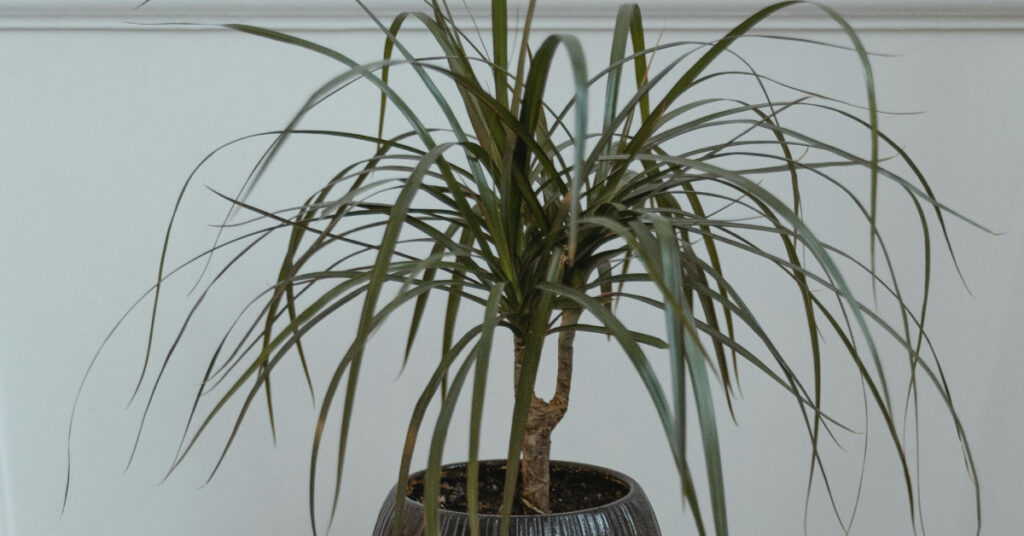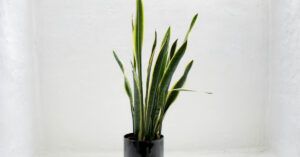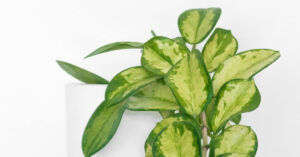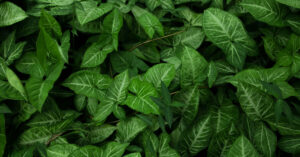Dracaena marginata
Dracaena stands as the perfect indoor tree, combining elegant, palm-like beauty with remarkable adaptability and easy care requirements that make it ideal for creating sophisticated focal points in any space. This stunning specimen delivers the architectural presence of a tree while remaining perfectly suited for indoor life, making it the go-to choice for anyone seeking dramatic height and tropical elegance without outdoor gardening complexity.
Why Dracaena Excels as Your Indoor Tree
Native to Madagascar and tropical Africa, Dracaena has earned its reputation as one of the most versatile and reliable houseplants, capable of thriving in a wide range of indoor conditions while maintaining its elegant tree-like form. Its slender trunk topped with clusters of sword-like leaves creates instant sophistication that works beautifully in modern offices, contemporary homes, and traditional settings alike. The plant’s naturally slow growth means it maintains its proportions for years without frequent repotting or aggressive pruning.
What makes Dracaena particularly valuable is its exceptional air-purifying abilities, recognized by NASA as highly effective at removing formaldehyde, xylene, and trichloroethylene from indoor air. The plant’s tolerance for lower light conditions and irregular watering makes it perfect for office environments and busy lifestyles, while its dramatic silhouette provides the kind of living architecture that transforms empty corners into stunning focal points.
Care Requirements
Light Requirements
Bright indirect to medium light
Dracaena demonstrates impressive adaptability to various lighting conditions, thriving in bright, indirect light while tolerating medium and even lower light situations remarkably well. Position your plant near windows with filtered light or in well-lit rooms away from direct sunlight, which can scorch the leaves and cause unsightly brown patches. The plant performs excellently under office fluorescent lighting and adapts well to north-facing windows where many other plants would struggle.
Watering
Moderate frequency
Dracaena prefers a relaxed watering schedule that allows the soil to dry slightly between waterings, making it forgiving for busy plant parents. Water when the top 1-2 inches of soil feel dry to the touch, typically every 1-2 weeks during the growing season. The plant tolerates both slight underwatering and occasional overwatering better than many houseplants, though consistent overwatering can lead to root rot and yellowing leaves.
Soil Type
Well-draining potting mix
Standard high-quality potting soil works excellently for Dracaena, as the plant adapts well to various soil conditions as long as drainage is adequate. The soil should feel moist after watering but never soggy or waterlogged. If your potting mix seems to retain too much moisture, adding perlite or coarse sand can improve drainage. The plant tolerates a range of pH levels but performs best in slightly acidic to neutral conditions.
Temperature
65-80°F (18-27°C)
Dracaena thrives in the warm, stable temperatures typical of most homes and offices, showing good tolerance for the temperature fluctuations common in indoor environments. Maintain temperatures between 65-80°F for optimal growth, though the plant can handle brief periods outside this range without significant stress. Avoid placing your dracaena near heating vents, air conditioning units, or exterior doors where sudden temperature changes occur.
Humidity
Medium to low
Unlike many tropical plants, Dracaena adapts well to average household humidity levels and doesn’t require special humidity considerations. It thrives in 40-50% relative humidity but tolerates both drier and more humid conditions. Occasional misting can help keep leaves clean and glossy, but it’s more about aesthetics than plant health. This humidity tolerance makes Dracaena excellent for offices and homes with forced-air heating and cooling systems.
Fertilizing
Light feeding during growing season
Dracaena has modest fertilizer requirements and actually prefers light feeding to prevent leaf tip burn that can result from over-fertilization. Apply a balanced liquid fertilizer monthly during spring and summer, diluted to half strength to avoid nutrient burn. The plant can thrive for extended periods without any fertilizer, making it perfect for low-maintenance care routines. Yellow leaf tips often indicate over-fertilization rather than nutrient deficiency.
Seasonal Care Adjustments
Spring/Summer (Growing Season):
- Water every 1-2 weeks as soil dries
- Monthly light fertilizing promotes healthy growth
- Ideal time for pruning to control height and shape
- Monitor for new growth at the top of stems
Fall/Winter (Slower Growth):
- Reduce watering frequency as growth slows
- Stop fertilizing during dormant period
- Lower light tolerance increases
- Growth naturally decreases—this is completely normal
Mature Size and Growth Habits
Dracaena typically reaches 6-10 feet in height indoors when given adequate space and time, though it can be maintained at smaller sizes through regular pruning. The plant grows slowly and steadily, usually taking 5-7 years to reach substantial size, which means it provides long-term satisfaction without quickly outgrowing its space. The characteristic trunk develops gradually as lower leaves naturally drop, creating the tree-like appearance that makes Dracaena so valuable as living architecture. With proper care, these plants can live for decades, often becoming treasured specimens that anchor room designs.
Difficulty Level
Easy to moderate
Dracaena occupies the sweet spot between beginner-friendly resilience and rewarding plant care, making it excellent for those ready to graduate from ultra-low-maintenance plants while still wanting reliable success.
Pet and Child Safety
Important: Dracaena is toxic to pets, particularly cats and dogs, if ingested. The plant contains compounds that can cause vomiting, loss of appetite, depression, and excessive salivation in animals. While not typically life-threatening, consumption should be avoided. Keep Dracaena plants out of reach of curious pets, or choose pet-safe alternatives if ingestion is a significant concern. The plant is generally safe around children but should not be consumed.
Varieties to Consider
Dracaena offers several stunning varieties with different leaf patterns, colors, and growth habits:
- Dracaena marginata: Classic red-edged leaves with slender form
- Dracaena fragrans ‘Massangeana’ (Corn Plant): Broad leaves with yellow striping
- Dracaena reflexa ‘Song of India’: Compact form with yellow-edged leaves
- Dracaena sanderiana (Lucky Bamboo): Small, bamboo-like stems often grown in water
- Dracaena compacta: Dense, compact growth with dark green leaves
- Dracaena lemon lime: Bright chartreuse and green striped foliage
Plants That Pair Well with Dracaena
Dracaena’s tree-like form and moderate care requirements make it an excellent anchor plant for sophisticated indoor landscapes. Its upright architecture provides perfect backdrop while complementing both compact and trailing specimens.
Perfect Companions:
- Snake Plant – Complementary architectural forms with similar light tolerance
- ZZ Plant – Equally low-maintenance with contrasting glossy foliage
- Rubber Plant – Similar tree-like presence with different leaf textures
- Peace Lily – Contrasting soft foliage with elegant white flowers
- Pothos varieties – Trailing plants that soften the dracaena’s upright lines
Architectural Collections: Create stunning, office-appropriate displays by combining different Dracaena varieties with other structural plants like snake plants, rubber trees, and large philodendrons. These combinations work beautifully in professional and residential settings.
Aesthetic Pairings: Dracaena serves as an excellent structural backbone for plant groupings, providing height and drama while allowing smaller plants to create layered, dynamic displays. Its clean lines complement both modern and traditional décor styles.
Common Problems and Solutions
Overwatering
Symptoms: Yellow leaves, brown leaf tips, mushy stems, root rot, moldy soil
Solution: Reduce watering frequency, improve drainage, remove affected roots if necessary
Underwatering
Symptoms: Drooping leaves, brown crispy edges, soil pulling from pot sides
Solution: Water thoroughly and establish more consistent watering schedule
Low Light
Symptoms: Leggy growth, small new leaves, loss of lower leaves, pale color
Solution: Move to brighter location with indirect light
Fluoride Toxicity
Symptoms: Brown leaf tips and edges, yellowing despite proper care
Solution: Use distilled or filtered water, avoid fluoridated tap water
Pest Issues
Symptoms: Scale insects, spider mites, mealybugs on leaves and stems
Solution: Regular inspection, neem oil treatment, improve air circulation
Pruning and Shaping
Regular pruning helps maintain your Dracaena’s attractive shape while controlling its size and promoting bushier growth when desired.
Height Control: Cut the main stem at your desired height during growing season. New growth will emerge from below the cut, often creating multiple new growing points for a fuller appearance.
Removing Lower Leaves: Naturally yellowing lower leaves should be removed cleanly at the stem to maintain the plant’s tree-like appearance and prevent pest issues.
Propagation from Cuttings: Pruned sections can be rooted in water or soil to create new plants, making pruning both practical and rewarding for expanding your collection.
Timing: Late spring through early summer provides the best results for major pruning, allowing the plant time to recover and produce new growth during the active growing season.
Tool Care: Always use clean, sharp pruning shears to prevent disease transmission and ensure clean cuts that heal properly.
Propagation
Dracaena propagation is straightforward and offers multiple methods for creating new plants:
Stem Cutting Method:
- Cut healthy stem sections 4-6 inches long during growing season
- Remove lower leaves, keeping 3-4 leaves at the top
- Place cuttings in water or moist potting soil
- Keep in bright, indirect light with consistent moisture
- Roots develop in 3-4 weeks
- Transplant to permanent pots once well-established
Top Cutting Propagation:
- Cut the top growing section with several inches of stem
- Allow cut surface to dry for 24 hours
- Root in water or directly in soil
- Parent plant will often produce new shoots below the cut
Air Layering: For larger specimens, wound the stem, wrap with moist sphagnum moss, and cover with plastic until roots develop before cutting.
Your Sophisticated Indoor Tree Solution
Dracaena represents the perfect solution for anyone seeking the elegance and presence of an indoor tree without the complexity of high-maintenance specimens. Its combination of architectural beauty, air-purifying benefits, and remarkable adaptability makes it invaluable for homes, offices, and any space needing sophisticated greenery that thrives with minimal attention.
Whether you’re creating a living focal point for a modern interior, adding natural elegance to an office environment, or seeking a reliable plant that grows with your space over time, Dracaena delivers consistent beauty and satisfaction. Start with this elegant tree-like beauty, and you’ll discover the joy of having a plant that provides years of sophisticated presence while asking for surprisingly little in return.




